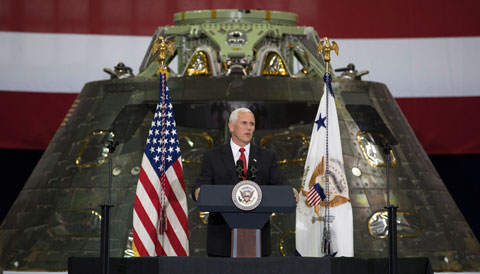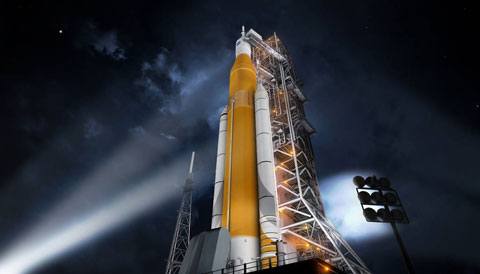What is the National Space Council and what will it do for the future of space exploration? A look back through history provides some possible answers.

NASA / Kim Shiflett
As President Donald Trump signed the order on June 30th re-activating the National Space Council, he suggested that the council would be “a central hub guiding space policy.” What are the prospects that, as Vice President Mike Pence recently claimed, “With the guidance of the National Space Council, the United States of America will usher in a new era of space leadership that will benefit every facet of our national life”? To gain a sense of the council’s possible impacts, it’s useful to see this act in a historical context.
It’s important first to understand that the National Space Council itself is just a committee of top-level administration officials. That committee, with Pence as its chair, will include the head of NASA, the Secretaries of State, Defense, Commerce, Transportation, and other cabinet departments, the Director of National Intelligence, the Chairman of the Joint Chiefs of Staff, and, from the White House, the National Security Adviser and the Directors of Office of Management and Budget (OMB) and Office of Science and Technology Policy (OSTP). The council will have a full-time staff of unspecified size, headed by an Executive Secretary. It is that individual, and his or her staff associates, who will be the key players in carrying out the ambitious tasks assigned to the council. The council will also have a part-time “Users Advisory Group,” composed of “representatives of industries and other persons involved in aeronautical and space activities.”
Given the senior status of its members, and the reality that they have many other things to do besides space policy, the space council is unlikely to meet frequently. When its members do gather, they will discuss and decide on proposals reflecting the work of council staff and resulting from interagency discussions of the diverse policy issues in the space sector.
Space Council Timeline
This is the third time a National Space Council has existed. The first council was created on congressional initiative as part of the 1958 Space Act and existed until President Richard Nixon abolished it in 1973. Fifteen years later, Congress recreated the council, and it was activated in 1989, in the first months of the George H.W. Bush administration. That council was de-activated in January 1993 as part of President Bill Clinton’s campaign pledge to reduce the size of the White House and Executive Office staff by 25%.
The space council has had some success stories along the way. In 1961 the council organized the consultations that led to President Kennedy’s decision to go to the Moon, and in 1962 had a major role in shaping the framework for a commercial communications satellite industry. During the Nixon administration, the council had no visible impact on post-Apollo decisions, but in 1989, council staff working with NASA crafted the Space Exploration Initiative announced by President Bush. The council also took the lead in space engagement with Russia after the collapse of the Soviet Union.
Those successes, however, were not been enough to establish a space council as an essential element of space policymaking. Eisenhower, whom the Space Act had made the council chair, did not hire a staff and never called a council meeting. President Kennedy revised the legislation to make the vice president the council chair, but after 1961 he often bypassed Vice President Johnson and the space council staff in making his space choices, preferring to depend on his science and national security advisers. After Johnson became president, he gave little attention to space issues and his vice president, Hubert Humphrey, did not make space policy a major focus of attention. By the time Richard Nixon was elected president in 1968, the council was essentially moribund.
The Nixon administration initially hoped to revitalize the space council, hiring Apollo 8 astronaut Bill Anders as Executive Secretary. Anders was able to carve out a useful lower-level role in post-Apollo decisions, but working through Vice President Spiro Agnew, who had no policy clout, as council chair was too much of a burden, and it was Anders among others who recommended in 1972 that the council be dissolved.
During the 1989-1993 Bush administration, as the council was re-activated, Vice President Dan Quayle took his role as chair seriously and assembled a politically astute, substantively qualified, and activist staff. The incoming Clinton administration’s decision to de-activate the space council was more a case of change for change’s sake than a negative judgment on the efficacy of the Council mechanism.
Prospects for the Future

NASA / MSFC
What does this compressed historical review suggest are the prospects for the Trump/Pence National Space Council? First of all, there is a pressing need for coherence in managing the increasing complex U.S. space enterprise. With NASA hoping to resume human travel to distant destinations, with national security dependent on space capabilities, with the space environment increasingly congested, competitive, and contested, and with a multi-faceted U.S. private space sector emerging, coordination becomes imperative. The time is ripe for a well-crafted national space strategy that takes all of these factors into account. The opportunity for the National Space Council to develop that strategy and oversee its implementation is clear.
That will happen only if the new council has the active support of President Trump and becomes a major element of Vice President Pence’s portfolio. Assembling a highly qualified Space Council staff is of course essential, but that staff can be effective only if it is seen as having White House political support as it attempts to influence agency behavior.
In July 6th remarks at the Kennedy Space Center, Vice President Pence quoted President Trump as saying that the United States was “going to be leading” in space “like we’ve never led before.” Whether this is more than rhetorical boasting is yet to be seen, but if renewed space leadership does become reality, it is likely that the revived National Space Council will be key to that achievement.
 8
8
Comments
Anthony Barreiro
July 11, 2017 at 6:14 pm
In general I believe that robotic space exploration is much more cost effective than human space flight. But if we could put President Trump, Vice President Pence, and the rest of the National Space Council* in an Orion capsule and send them on a one-way trip to Mars, I would make an exception this one time.
* NASA Administrator Frank Bolden has specialized expertise relevant to the success of the mission, so we would need to keep him in Houston to oversee ground control.
You must be logged in to post a comment.
Anthony Barreiro
July 11, 2017 at 6:17 pm
Whoops -- Charles Bolden.
You must be logged in to post a comment.
StarChaser55
July 12, 2017 at 7:31 pm
I have enjoyed reading the Sky and Telescope comment section for many years; it is a shame to see partisan politics invading what used to be a fine forum. People from across the political spectrum need to work together, not against one another to support scientific exploration.
You must be logged in to post a comment.
Anthony Barreiro
July 13, 2017 at 3:52 pm
Starchaser, our current US government (elected by a minority of the population) has rejected the established scientific consensus on many issues of public concern, most glaringly human-caused global climate change, and they are ignoring US environmental laws and abrogating our international obligations to address climate change. Sure, we can work together with them on some marginal scientific goals that don't threaten the economic interests of polluting extractive industries, but we also need to challenge them when they are simply wrong. If you have any sway with people at that end of the political spectrum, please try to help them understand how science works.
There is a political crisis in this country, and if we ignore it we are endangering future generations. I am sorry to sully your fine forum with this reality.
You must be logged in to post a comment.
Peter Wilson
July 14, 2017 at 12:06 pm
Science, in a way, has become a victim of its own success. All the “simple wonders”--What are those points of light in the night sky?; Why do some of them move?; What makes the sun shine?--now have staid answers. No child has ever gazed at dark matter, and wondered: What is that made of?
Besides becoming highly abstract, science is now answering questions we are uncomfortable with: What is going to happen if we keep burning fossil fuels like there’s no tomorrow? What will happen if all the forests are cut down? If all the aquifers are pumped dry? If all the fish are fished from the ocean? Science may yet find a way to make jelly-fish edible, but lately it has become the source of a lot of bad news. For these and other reasons, science has lost a lot of its popularity. I see no easy answers.
You must be logged in to post a comment.
Stub Mandrel
July 15, 2017 at 4:38 am
From a perspective on the other side of the Atlantic, NASA has got much better at its outreach and communications. Sadly they don't always make things as straightforward and simple in operation as they could.
The public domain status of NASA images is remarkable and there ought to be more effort to encourage young people to explore, interpret and USE these images - they are part of their heritage.
The store of 3D models could be a big plus for outreach, if only they were better presented and interpreted, and those that don't fit together well or print properly should be fixed or removed - don't frustrate youngsters! NASA should look at Ultimaker's 3D Tyrannosaurus and its lesson plans.
NASA's Eyes is good, but again it lacks context, lesson plans etc. etc.
Finally, I remember the excitement around the Apollo program from well before the first landing, and I was only born in '62. Every space launch is an opportunity for outreach and learning, even those that fail or end in tragedy open our thoughts to the reasons why we attempt these things.
NASA should learn from SpaceX and their success in presenting their launch footage in a compelling way (although even SpaceX could do with a bit more technical explanation and higher production values: Instead of brief cuts to the significant events on a mission, build the excitement and then replay in slow motion, or label the images, or give the presenter a 3D model so they can show how it all works.)
You must be logged in to post a comment.
July 19, 2017 at 6:11 am
Just to lessen the tension in these times of social-mayhem, I am reminded of when President George H.W. Bush appointed his vice-president to NASA - J. Danforth Quayle - who was widely considered the most ignorant man on Earth - and the following joke made wide rounds in the scientific communities:
Dr. A - "So I hear Mr. Quayle intends to land a spacecraft on the Sun to explore it!"
Dr. B - "That's crazy! It would be incinerated!"
Dr. A - " Oh not to worry. They'll be landing at night!"
Oh hi Stub - Dave In Vermont here.
You must be logged in to post a comment.
Marc Dubbeldam
February 2, 2018 at 6:25 am
Great anecdote; reminds me of my granny who was worried sick during the Moon landings: "I hope it's a full moon!" "Why?" "Well, otherwise they might miss it..."
You must be logged in to post a comment.
You must be logged in to post a comment.